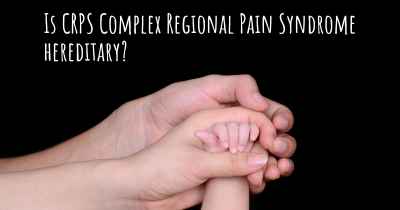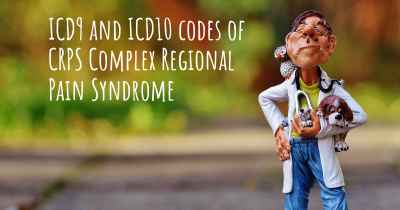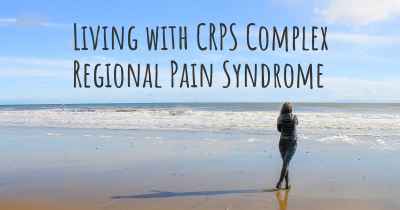14
How do I know if I have CRPS Complex Regional Pain Syndrome?
What signs or symptoms may make you suspect you may have CRPS Complex Regional Pain Syndrome. People who have experience in CRPS Complex Regional Pain Syndrome offer advice of what things may make you suspicious and which doctor you should go to to receive treatment

Pain that is lasting longer than 6 months is considered chronic
Posted Sep 6, 2017 by [email protected] 5060
Symptoms are the best way to know if you have it. It is something I think would be impossible to fake.
Posted Sep 11, 2017 by Craig 1600
Mine was diagnosed theough pain consultant and neuro consultant jointly with input from pain psychologist too.
Posted Sep 13, 2017 by Andy 3550
You might suspect you have CRPS if you have suffered a trauma anywhere on a limb. CRPS most commonly occurs after foot or ankle surgery to repair a fracture or sprain, but it can develop from something as innocuous as a needle stick. Symptoms include severe and continuous pain in part or all of a limb. It has been described as "burning" or a combination of burning and electrical shocks. If CRPS happens after an injury, the pain of the injury may be unusually severe. For example an ankle sprain may trigger an unbearable burning sensation. The affected part can become hypersensitive. Touching, bumping, or exposing the limb to temperature changes may cause severe pain. Muscle atrophy, or wasting, can result, if the patient stops using the limb because of the pain.
There may also be:
• Changes in skin temperature, with the skin becoming sweaty at times, and cold and clammy at others
• Changes in skin color, causing blotches or streaks, ranging from very pale to pink, and perhaps even with a blue tinge
• Thin and shiny skin texture
• Unusually fast or slow nail and hair growth
• Painful, stiff and inflamed joints.
• Mobility may also be reduced, as patients find it hard to move the affected part.
CRPS must be diagnosed by a medical doctor, preferably someone with a specialty in pain management.
There may also be:
• Changes in skin temperature, with the skin becoming sweaty at times, and cold and clammy at others
• Changes in skin color, causing blotches or streaks, ranging from very pale to pink, and perhaps even with a blue tinge
• Thin and shiny skin texture
• Unusually fast or slow nail and hair growth
• Painful, stiff and inflamed joints.
• Mobility may also be reduced, as patients find it hard to move the affected part.
CRPS must be diagnosed by a medical doctor, preferably someone with a specialty in pain management.
Posted Sep 15, 2017 by DrLisa 3750
Seek a professional opinion from a specialist in pain or Neurologist. If it's pain like nothing else you have experienced and swelling, then maybe you have CRPS
Posted Sep 19, 2017 by Alex 2550
If you continue to have pain after an injury or surgery that has healed you need to find a doctor who specializes in chronic pain. If you are still having pain after an injury has healed say a broken ankle, get to a pain clinic quickly. You have to be your own health care advocate. Ask questions, ask for referrals, keep asking.
Posted Oct 8, 2017 by Valerie 1500
Your doctor will formally diagnose you but refer to the symptoms above
Posted Nov 11, 2017 by Robbie 2000
You won’t know until you visit a doctor with knowledge.
You may have tingling, hyper sensitive to touch, textures and cold and heat. Your skin will look different and may be ice cold, flame red or even blue. You affected area may continually throb and more
You may have tingling, hyper sensitive to touch, textures and cold and heat. Your skin will look different and may be ice cold, flame red or even blue. You affected area may continually throb and more
Posted Nov 11, 2017 by Aj 2000
It requires a doctor's diagnosis.
Posted Nov 11, 2017 by Colleen85201 1700
Do you have a burning hot and icy pain thst is extreme compared to the site of injury? Does it get worse or not go away after the original injury heals?
Posted Nov 12, 2017 by Shanna 5000
If you have pain that lingers long after your injury has healed. You should go to your primary doctor who can make the appropriate referrals.
Posted Nov 12, 2017 by ladyff1481 2050
Only by a medical expertise. Orthopedic surgeons are the best qualified.
Posted Nov 12, 2017 by Thea 3150
Pain lasting for more than 3 months is considered chronic and should be thoroughly investigated.
Posted Oct 25, 2018 by Misty 2100
Pain that is higher than what the injury normally is. Swelling, shiny purplish/blue skin. Excessive sweating and change of nail texture. Inability to move fully.
Posted Nov 1, 2018 by Judy 3000
Injury has healed but the pain continues. Pain that is burning and feels like it is been crushed in a vise. Color change to the area. Sensitivity to touch. Go to a Neurologist and or Specialist to be diagnosed and to start pain management.
Posted Jan 5, 2019 by Cynthia 4000
Pain that is described as deep, aching, cold, burning, and/or increased skin sensitivity
An initiating injury or traumatic event, such as a sprain, fracture, minor surgery, etc., that should not cause as severe pain as being experienced or where the pain does not subside with healing
Pain (moderate-to-severe) associated with allodynia, that is, pain from something that should not cause pain, such as the touch of clothing or a shower
Continuing pain (moderate-to-severe) associated with hyperalgesia, that is, heightened sensitivity to painful stimulation)
Abnormal swelling in the affected area
Abnormal hair or nail growth
Abnormal skin color changes
Abnormal skin temperature, that is, one side of the body is warmer or colder than the other by more than 1°C
Abnormal sweating of the affected area
Limited range of motion, weakness, or other motor disorders such as paralysis or dystonia
Symptoms and signs can wax and wane
Can affect anyone, but is more common in women, with a recent increase in the number of children and adolescents who are diagnosed
An initiating injury or traumatic event, such as a sprain, fracture, minor surgery, etc., that should not cause as severe pain as being experienced or where the pain does not subside with healing
Pain (moderate-to-severe) associated with allodynia, that is, pain from something that should not cause pain, such as the touch of clothing or a shower
Continuing pain (moderate-to-severe) associated with hyperalgesia, that is, heightened sensitivity to painful stimulation)
Abnormal swelling in the affected area
Abnormal hair or nail growth
Abnormal skin color changes
Abnormal skin temperature, that is, one side of the body is warmer or colder than the other by more than 1°C
Abnormal sweating of the affected area
Limited range of motion, weakness, or other motor disorders such as paralysis or dystonia
Symptoms and signs can wax and wane
Can affect anyone, but is more common in women, with a recent increase in the number of children and adolescents who are diagnosed
Posted Jan 16, 2021 by Patricia 3050
If you suspect you have Complex Regional Pain Syndrome, you should go see a neurologist or someone who specializes in neurology. Some common symptoms are:
-constant burning
-cold skin
-color changes
-nerve pain
-constant burning
-cold skin
-color changes
-nerve pain
Posted Mar 29, 2021 by Sage0920 2000
Medical diagnosis. By exclusion and lots of other tests suchbas blood profiles etc. Visual symptoms ( in my case) did not set in for a while but colour changes such as fingers turning completely black.or purple and white, not to mention bright purple knees was very frightening.
Posted Nov 3, 2022 by Heather 5020








